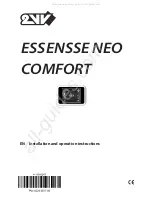
Fridgewatch 2100 Controller Mk4
Publication 3-58
Section 3
Page 22 of 152
Issue 1.1 : 01/08
Slide valve position for HallScrew 3100 new series, 3200 and 4200 series
compressors is provided by a Linear Variable Displacement Transducer
(LVDT). The LVDT provides the usual 4 to 20 mA signal but is usually
provided without any calibration on the LVDT. Fridgewatch 2100 needs
to be told when the signal corresponds to minimum and maximum slide
valve position. This facility is provided by S63 setting 4 and the
procedure described in 12.5. Calibration of LVDT 4 to 20 mA Signal – HS
3100 New Series, HS 3200 and HS 4200 Series Compressors.
5.2.
Proportional, Integral and Derivative (PID) Control
Before discussing Proportional, Integral and Derivative (PID) control, it is
necessary to define some basic terms:
•
Set point
- the value of pressure or temperature it is desired
to control to.
•
Measured variable
- the analogue value of temperature or
pressure sensed by the control system, usually via a
pressure transducer or resistance thermometer.
•
Control error
- the difference between the measured
variable and the set point.
•
Start value
- the value of pressure or temperature above
which the compressor starts when auto start/stop mode is
selected.
•
Stop value
- the value of pressure or temperature below
which the compressor stops when auto start/stop mode is
selected.
The PID control algorithm allows Fridgewatch 2100 to be tuned to suit
any type of control situation. Each component of the PID algorithm
makes a specific and variable contribution towards limiting the control
error as illustrated in Fig 7.
The size and rate of change of the error determines the amount of
corrective action (capacity control slide valve movement) taken by
Fridgewatch 2100 to bring the measured variable to match the set point.
Fridgewatch limits the corrective action taken at each error assessment
to a maximum of 10 load/unload pulses.
After each error assessment Fridgewatch 2100 waits for a period, the
sample time, to allow the refrigeration system to respond to the change in
compressor duty. Fridgewatch then re-assess the size of the error and
the trend, towards or away from the set point, before taking further control
action as necessary.
5.2.1. Proportional
Band
A band, known as the proportional band, is defined either side of the set
point. If the size of the error is greater or equal to the proportional band,
Fridgewatch 2100 takes the maximum corrective control action. If the
error is smaller than the proportional band, Fridgewatch takes corrective
action scaled down from the maximum value by the ratio of the error to
the proportional band, i.e. the closer the measured value is to the set
point the smaller the corrective action and vice-versa. If the error is zero,
or if the scaled corrective action is smaller than the minimum possible
corrective action, no action is taken.
















































